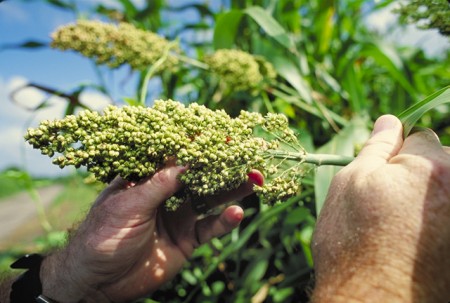Jun
21
Is There A Better Choice Than Corn For Biofuel?
June 21, 2012 | 2 Comments
Those attributes point to potential adoptability for sorghum. Scientists from Purdue, the University of Nebraska-Lincoln, University of Illinois and Cornell University believe sorghum, a grain crop similar to corn, could benefit from the rail system, grain elevators and corn ethanol processing facilities already in place.
Nick Carpita, a Purdue professor of botany and plant pathology said, “The Midwest is uniquely poised to get the biorefining industry going on cellulose. As we move to different fuels beyond ethanol, the ethanol plants of today are equipped to take advantage of new bioenergy crops.”
The scientists argue that no single plant is a silver-bullet answer to biofuels, but sorghum should be a larger part of the conversation than it is today. Cliff Weil, a Purdue professor of agronomy, said some types of sorghum would require fewer inputs and could be grown on marginal lands.
Weil points out, “In the near future, we need a feedstock that is not corn. Sweet and biomass sorghum meet all the criteria. They use less nitrogen, grow well and grow where other things don’t grow.”
The ability to minimize inputs such as nitrogen could be a key to sorghum’s benefits as a bioenergy crop. Carpita said corn, which has been bred to produce a maximum amount of seed, requires a lot of nitrogen. But sorghum could be genetically developed in a way that maximizes cellulose, minimizes seeds and, therefore, minimizes inputs.
Another plus is farmers may also be more willing to grow sorghum – a crop they’re familiar with – because it is an annual, compared with perennials such as switchgrass or Miscanthus, that would take up a field for a decade or longer. Sorghum would fit in a normal crop rotation with food crops rather than tying up valuable cropland.
One crucial point not noticed in the media, press or blogs is as Nathan Mosier, a Purdue associate professor of agricultural and biological engineering points out, “If we’re talking about planting switchgrass, that’s a 15-year commitment. You can’t switch annually based on the economy or other factors. You are committed to that crop.”
For income the farm operator and capital investment owner would have to believe that producing companies and government policy would stand behind the commitment. This is not something easily believed.
Even today just using the corn ethanol available isn’t possible – from a lack of flex fuel vehicles, regulatory impediments, and competitive industry pressure. E-15 has been dawdled on for years now.
Maureen McCann, a Purdue professor of biology and director of the Energy Center and the Center for Direct Catalytic Conversion of Biomass to Biofuels notes conversion processes for turning biomass into fuel need to be scalable and take advantage of existing infrastructure for grain production. Sorghum could be harvested and transported using existing rail lines to collection points such as grain elevators, where the crop could be processed to a higher-value, more energy-dense product before being transported for further processing in a refinery. That would seem an odd concept to folks in the corn belt where most all rail lines have been abandoned with only major routes for international export or North American long distance transport still operating.
Yet McCann has worthwhile points that should fit for trucking, the primary form of heavy transport in the corn belt, “Biomass has roughly half the energy content of gasoline – even if it’s very compressed and tightly packed. The issue is really how to increase the intrinsic energy density by preprocessing conversion steps that could be done on farm or at the silo so that you’re transporting higher-energy (density) products to the refineries.”
Purdue’s Farzad Taheripour, a research assistant professor of agricultural economics, said bringing sorghum back as a biofuel crop could have an economic impact on poorer rural areas of the country. “Given that sorghum can be produced on low-quality, marginal lands in dry areas, producing sorghum for biofuel will significantly improve the economy of rural areas that rely on low-productivity agriculture. This could improve welfare in less-developed rural areas and increase job opportunities in these areas.”
The good folks the universities have missed the point – sorghum is a crop long used on farms and found wanting. Sorghum offers quality attributes to production of biofuels, but the market is still at war over ethanol in particular and other biofuels can expect the same multiyear problems. Sorghum has no political base as a special interest like corn farmers, processors and blenders, knowledgeable environmentalists and well-informed consumers. But the big problem is capital, the financing to install a transport, storage and processing handling systems costing of hundreds of billions of dollars.
There is over a hundred years of investments in handling grains worldwide – nothing remotely similar exists for handling cellulosic materials. The logistical framework doesn’t exist.
Sorghum is great material for biofuel, a very interesting cellulosic resource that isn’t at all compelling for risk or investment. Not yet by any means. But the study does show that the transition to a cellulose resource from a corn resource is possible and that sorghum might be the ideal first step.
Comments
2 Comments so far



Plus if the bottom drops out in the alternative fuels market – you can always squeeze out some sorghum syrup. It goes well on a hot buttered biscuit!
[…] Source: Is There A Better Choice Than Corn For Biofuel? […]